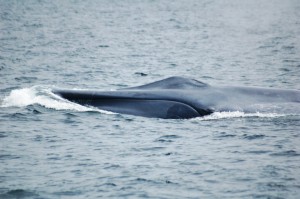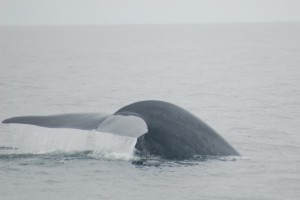
Photo credit: Bobbie Hedges
And now ladies and gentlemen…drum roll please…introducing the largest animal to ever live on earth, bigger than the largest dinosaur, as long as two school buses stacked end to end a whopping 80 feet, weighing on average 85 tons with a heart the size of a Volkswagen Beetle…I now present to you—the blue whale.
Yes, the introduction is a bit much, but everything about the Blue Whale is wondrous hyperbole, yet not hyperbole at all because it’s all true, no exaggeration necessary. Fanfare is the only way to properly introduce the largest animal to ever live on earth.
And yet, the blue whale is scientifically named Balaenoptera musculus, meaning winged mouse.
According to the Guide to Marine Mammals of the World, Balaenoptera, the genus name given to several whales means winged and musculus the distinguishing name bestowed upon the Blue Whale means muscle or mouse. The authors suggest that mouse is the true meaning and a possible joke by Linnaeus, the Swedish taxonomist who named the blue whale.
Ah, Linnaeus, you crazy jokester, we’ll never know what you were really thinking. Or should I say drinking?
Nonetheless, the winged mouse, I mean blue whale, now also holding the record for the world’s most ironic scientific name, is a glorious sight to behold.
The blue whale is blue, but of course it’s not that simple, the color is actually gray just like a mouse, but appears blue when viewed through the water. The skin has a blotchy look, with the color displayed in lighter and darker patterns that are unique to each Blue Whale allowing scientists to identify individual whales and monitor their activities over time.
If you are out whale watching, the size of the whale’s blow, meaning air exhaled through its blowhole, is the best thing to look for. A blow that looks like a mini-tower is one indication of a blue whale because their blows can be up to 40 feet high. Another unique characteristic is the large splash guard protruding around the blow holes on the top of its head. It looks like a viewfinder or a whale version of a cup holder, hard to describe but you’ll know it when you see it.
And since they are the largest whale, when Blue Whales dive it seems like their backs keep going and going, then finally you see a disproportionately tiny dorsal (back) fin. Ah ha! Maybe Linnaeus named the blue whale after its strange mouse-sized fin.
Finally if you are lucky a beautiful broad flattened triangle fluke (tail) will salute you before diving into the deep. This dive could easily be a quest for food. And here is another great paradox of the blue whale, the largest animal in the world eats one of the smallest sea creatures, krill. Tiny, tiny shrimp-like crustaceans, krill are bug eyed whitish-pink marine dinner delights for blue whales.
Since krill are so small, blue whales eat up to four tons a day to ensure dinner is satisfactory. To do so, blue whales expand their enormous mouths taking in mass quantities of krill and ocean water. This job is made easier by ventral grooves (also referred to as pleats) that run length-wise on the whale’s chin down towards the throat. When the blue whale eats, these grooves expand like an accordion, stretching to hold as much krill and water as possible. Once krill are captured, the blue whale presses its huge tongue pushing the water out while the krill remain trapped.
This system works thanks to the blue whale’s baleen.
As described by the Guide to Marine Mammals of the World, “Baleen consists of several hundred individual plates that hang down from the upper jaw in two racks, one on each side of the mouth. The inner surface of the baleen features a dense mat of hair, which serves as a strainer.”
This hair-like feature of baleen helped coin the scientific suborder name for baleen whales, Mysticetes, meaning moustache. The krill are trapped by these baleen hairs and swallowed whole.
These more obvious blue whale traits are better understood since they are shared with other baleen whales. But researchers are still studying and finding out more everyday about the blue whale’s communication techniques, migration patterns and reproduction habits.
The largest animal on earth has a very, very deep voice. According to John Calambokidis and Gretchen Steiger, whale research biologists and authors of the book Blue Whales, the blue whale’s voice is so low that some calls are below the range of our hearing and can only be measured using scientific monitoring equipment. Because of the way sound travels through the ocean, it’s possible that some Blue Whale calls can be heard across thousands of miles.
Unfortunately, migration patterns and reproduction habits are being pieced together slowly. Whaling decimated blue whale populations in the early 1900’s leaving scientists very few whales to study. Based on a lecture presented by Dan Bortolotti author of Wild Blue, 330,000 blue whales were killed in the Antarctic and 40,000 in the rest of the world, decimating 99.9 percent of the blue whale population. Since the ban on hunting blue whales in 1966, this severely endangered species is slowly recovering and current worldwide population estimates hover around 10,000.
Those of you feeling adventurous hoping to see this rare and magnificent animal can see blue whales right now near Santa Barbara. On a recent whale watching trip I had the opportunity to see blue whales feeding right near the boat, their accordion mouths gulping krill at the surface. Simply breathtaking!
And if you do go blue whale watching, take a moment to salute the largest creature to ever live on earth, giving this venerable animal the respect it deserves by recognizing the title it holds on our planet and our role in its current plight.

[…] more detailed information on blue whales here’s a link to the column I wrote Blue Whales: the largest animals to ever live on earth.) Share and […]